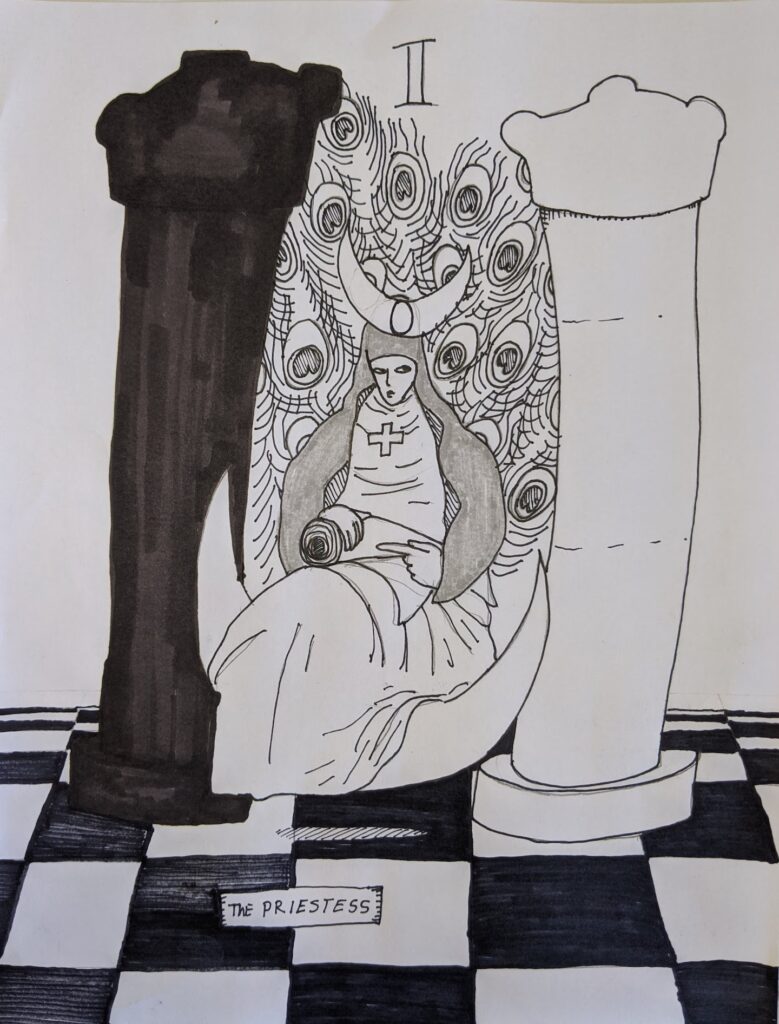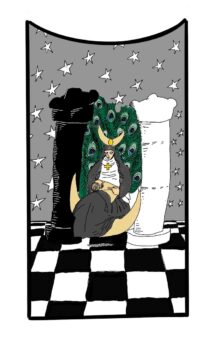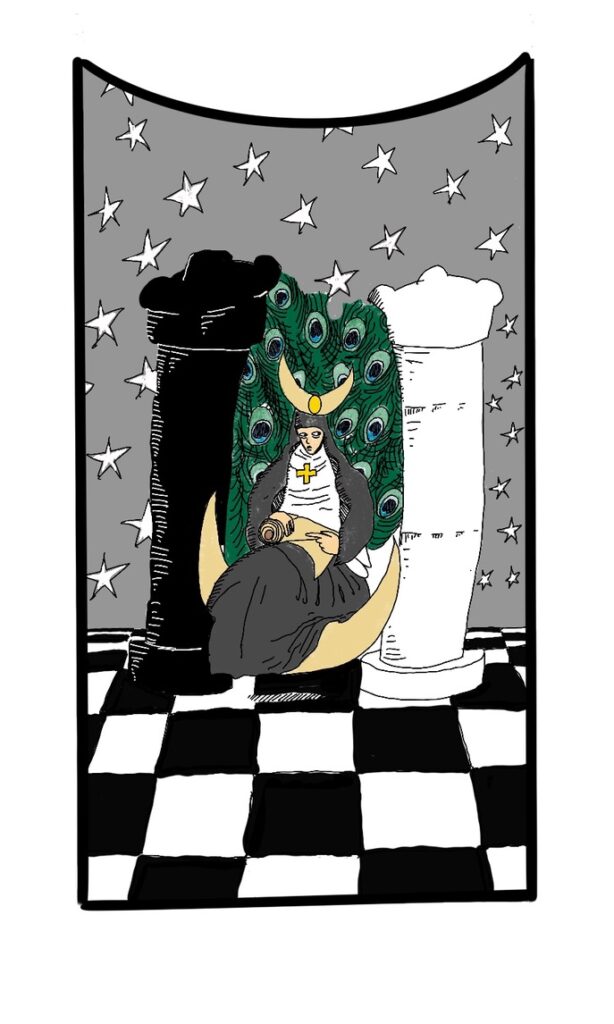Welcome to the third card of the Infinite Fool Tarot, the Priestess. You can read about the Fool, the Magician, and why I did my tarot deck by clicking the links. The Priestess is the number two card of the deck and is the first feminine character the Fool runs into on his journey through this world.
The Priestess sits on top of a moon in robes, holding a scroll. Beneath her is a black and white checkered floor that goes off as far as the eye can see. In the distance, it is hard to decipher whether it is a fabric with stars or the actual sky. A black pillar sits on the Priestess’s left, and a white pillar to the right. A moon sits as a crown on the Priestess’s head and a cross on her chest.
The Fool has finally entered the real portal from our conscious world to the subconscious. The Peacock feathers that are fanning behind the Priestess are the last barrier between the Magician’s world of tools and materialism and the dreamscape of the subconscious. Only by bridging the gap between these two are we to heal.
This card has a lot to say about duality. The duality of the sexes, the duality of day and night, what is above, so is below, and good and evil. This doesn’t mean that the Priestess is a binary person, but she speaks calmly about intuition. She might be the soft voice that speaks about right and wrong in our minds.
The cross is the four elements. Everything can be made by fire, water, earth, and air. It can also mean body, heart, mind, and spirit. Again, the four minor arcana are presented by the character. The body is the pentacle, the heart is cups, the mind is the sword, and the spirit the wand. But instead of physical forms, these are internal in the Priestess; she embodies them.
The scroll usually hints at being the Torah and is partially hidden to symbolize the duality of the written-in-stone laws and the silent laws and traditions that one can’t see on the walls of temples. We must always strive to learn the spaces between the black and white. Simple acceptance of these laws is insufficient to get beyond the material plane.
Spirituality is about progress, and progress is pushing ourselves to the limit. We can find ourselves uncomfortable for an extended period, but we can come out to the other side a more substantial, wiser person.
This card is very feminine, the woman, the moon, the stars, but it isn’t without its masculine symbols, especially the peacock feathers that form a thin curtain between the material world and the spirit world. To go between the two pillars is to leave what you know behind. The Magician is safe; his tools are well-known and easy to use. The way of the Magician is simple and comfortable. We rely on the material, the external world, to make us feel good, but to walk past the Priestess is to fall into the unknown.
The Priestess is based on a female pope. The Catholic church does not allow women to be popes, which makes this card mysterious. Something is not what it seems; it means things that were once unacceptable are acceptable. We must question what we know as fact and question these beliefs, even if we have examined them before, for we and the world around us change.
The Priestess is the keeper of divine knowledge, the great mysteries, the esoteric. While the Magician kept reason, intellect, and material knowledge, the Priestess invites you to look inside yourself for an internal power you can rely on for strength and intuition.
Like the Devil, the Priestess is a guardian between two worlds. She welcomes the Fool to the next precipice he must step off of with faith. There is no dog this time; he must trust the Priestess and cross the boundary. Crossing the threshold into a different room in the house can do a lot to the subconscious.
To not trust the Priestess is not trusting your intuition. This is second-guessing that quiet voice or that gut reaction. While a little reason is good in making a decision, nothing beats that initial intuition, but we can lose trust in that and start to worry about what other people think of us. We begin to believe we cannot make these decisions independently without the threat of judgment from others.
While it seems like the Fool starts the journey and the Magician is the first guide of this new world, it is the High Priestess who calls on the wanderer to begin the spiritual journey. This is where the Fool will travel into a mysterious world and learn about things tucked far away in the long shadows of his mind. The Priestess will watch the Fool part of the peacock feathers and look for something buried deep.





